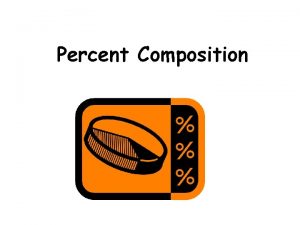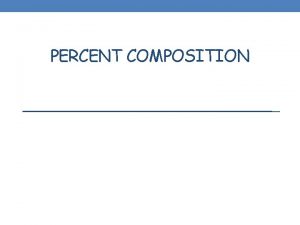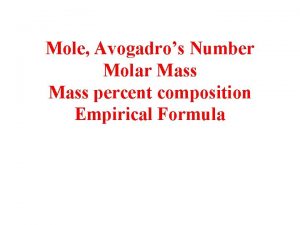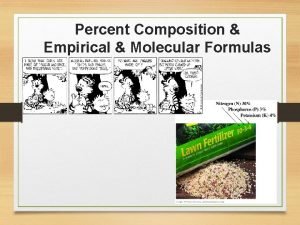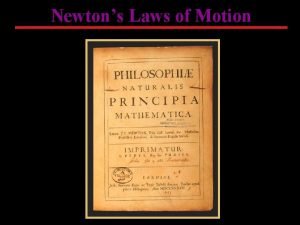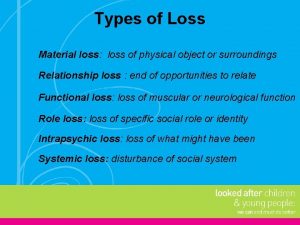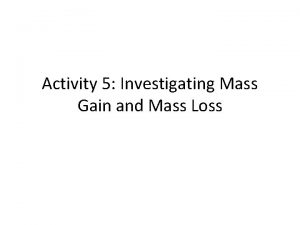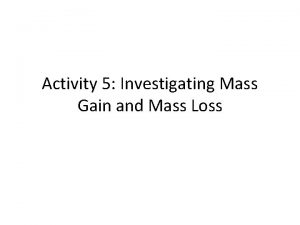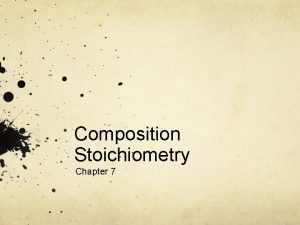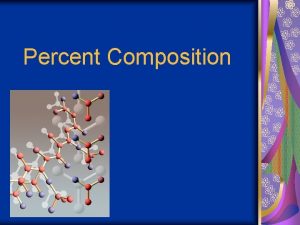Composition and Mass Loss Composition and Mass Loss



















- Slides: 19

Composition and Mass Loss

Composition and Mass Loss Two of the major items which can affect stellar evolution are Composition: The most important variable is Y – the helium content Mass Loss: core evolution is essentially independent of envelope evolution especially during later phases. This means that “lower” mass stars can have a “high” luminosity. Composition and Mass Loss 2

Composition Y is the more important Where this is of greatest impact is in the lifetimes of Pop II/III stars n n In Pop II (Z ~ 0) t 102 X and since X is somewhat larger than in Pop I one gets a longer lifetime. The converse is that He rich stars leave the MS very quickly. Y changes from 0. 3 → 0. 2 (at Z = 0. 03) At 5 M Teff decreases 10% and L decreases by a factor of 2 Composition and Mass Loss 3

Heavy Metal Effects This is for the Main Sequence Changes in Z lead to evolutionary changes essentially opposite to those in Y but are smaller. n Z decreases : L and Teff increase This means Pop II stars should be more luminous and hotter than Pop I ( at the same X, Y) Composition and Mass Loss 4

Post-MS Composition Effects Y is more important than Z for fixing the luminosity As a star evolves Z becomes more important as the energy generation involves Z (CNO dominates in higher mass stars, if there is CNO) The Teff position of the red giant branch is insensitive to Y or Z but the luminosity varies by a factor of 4 according to Y/Z Composition and Mass Loss 5

A Problem: Convective Mixing There is “no” good ab initio theory of convection Mixing length: defined as some fraction of the pressure scale height General number used is 1. 5 Composition and Mass Loss 6

Mass Loss Solar Mass Loss – The solar wind n n Flux = 10 p / cm 3 with V = 400 km/s V must be greater than Vesc Solar Vesc = SQRT(2 GM/R) = 620 km/s at R and 42 km/s at 1 AU. Current Solar Mass Loss Rate is about 10 -14 M /year n Integrated Mass Loss 10 -4 M if the rate has been constant. Observed Rates are up to 10 -4 M / year and are mass dependent. Composition and Mass Loss 7

P Cygni Stars Composition and Mass Loss 8

Gamma Cas Composition and Mass Loss 9

What Does Mass Loss Do To Stellar Evolution? Let us consider two stars with identical composition and the same current mass: n n Star 1: Constant Mass Star 2: d. M/dt = -a M / year Obviously Star 2 at t = 0 was more massive than Star 1 It evolved faster. Assumptions: n n Both convert equal H to He Equal amounts of radiation (energy) produced. Composition and Mass Loss 10

How Do We Proceed? Assume L ~ Mα (This is reasonable – α is about 3 to 3. 2) Note that MαT is just the total energy produced. n n T = age of constant mass star T' = age of star with mass loss rate d. M/dt Assuming the M(t) is known one can solve for T' given M 2, α , and T. Composition and Mass Loss 11

What Happens? a parameterizes the mass loss The sensitivity of the track to the mass loss rate depends on the initial mass: n n Higher mass stars can sustain a somewhat higher rate without changing the evolution. The integrated mass loss as a fraction of the total mass is comparable. Mass loss of 10 -12 M or less have little effect on M ~ 1 M Mass loss of 10 -9 M or less have little effect on M ~ 5 M Composition and Mass Loss 12

Rates That Matter For a 1 M star 10 -10 M / year will halve the MS lifetime n Original mass of 1. 4 M For a 5 M star 10 -6 M / year will decimate (10%) the MS lifetime n Original mass of 12 M Note that the lifetime goes with the original mass as it sets the energy generation. Composition and Mass Loss 13

Ramifications Globular Clusters: If they are loosing mass then the age estimates are too large n n Measured mass loss rates are variable The age of the Universe anyone? Composition and Mass Loss 14

Planetary Nebulae Stars “blow off” mass in shells – planetary nebulae are the result of these episodes. Composition reflects extensive processing. n n C and O enriched Advanced evolutionary stage (post He burning) Thought to be post/during ascent to 2 nd Giant Branch. (Detach the shell during an envelope expansion phase) Alternate mechanism is the hyperwind model associated with the AGB stars of low mass. Composition and Mass Loss 15

PN Typical Shell Mass is 0. 01 M. Lifetime is about 50000 years n expansion leads to lowering of density until the material becomes some optically thin it cannot detected Core star is usually very blue - probably the core of an ex-red giant – Teff 50000 - 100000 K PN are binary systems in many cases. Composition and Mass Loss 16

Stellar Mass and the Final Stage of Evolution Chandraskhar Limit: 1. 41 M n n Electron Degeneracy support Observed white dwarfs in Pleiades and Hyades Turn-off masses are 4 - 6 M This means the original masses were in excess of 4 6 M they had to lose sufficient mass to get down to the Chandrasekhar limit. Composition and Mass Loss 17

Close Binaries Generally stellar evolution does not take into account close binaries: n Wide system P > years and the stars evolve without interacting Close Systems n Mass exchange through the La. Grange points Fill Roche lobe, push mass through and dump on the secondary Secondary then heats up and becomes the primary – these are Algol systems Barium and subgiant CH stars Cataclysmic Variables Composition and Mass Loss 18

Fate of Stars Category Mass Limits M Fractional Mass of Galaxy Fate a 1. 5 0. 6 WD b 1. 5 M 4 0. 2 WD c 4 M 8 0. 06 WD/NS d >8 0. 14 SN(NS) Composition and Mass Loss 19
 Normal loss treatment in process costing
Normal loss treatment in process costing Water percentage composition
Water percentage composition What is the percentage composition of oxygen
What is the percentage composition of oxygen Percentage by mass formula
Percentage by mass formula Formula for molecular formula
Formula for molecular formula Percent composition by mass
Percent composition by mass Empirical formula
Empirical formula Composition of air by mass
Composition of air by mass Empirical formula of lactic acid
Empirical formula of lactic acid Empirical formula
Empirical formula Relative atomic mass of beryllium
Relative atomic mass of beryllium Atomic
Atomic Atomic weight of oxygen
Atomic weight of oxygen Carbon-12 atomic number
Carbon-12 atomic number How to solve stoichiometric calculations
How to solve stoichiometric calculations Inertial mass vs gravitational mass
Inertial mass vs gravitational mass Moles liters and molarity
Moles liters and molarity Conversion from grams to moles
Conversion from grams to moles Molar mass def
Molar mass def Convert molarity to mass
Convert molarity to mass


